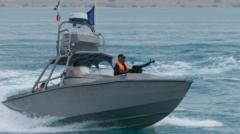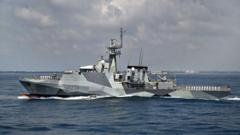China's recent deployment of steel cages and a decommissioned oil rig has stoked international tensions as South Korea questions their true purpose.
**Concerns Grow Over China's Aquaculture Structures in the Yellow Sea**

**Concerns Grow Over China's Aquaculture Structures in the Yellow Sea**
As China installs large structures in the Yellow Sea, South Korea expresses fears of military use.
China's introduction of a decommissioned offshore oil drilling rig and two massive octagonal steel cages in the Yellow Sea has brought speculation about their intended use. While Chinese authorities assert that these structures serve as deep-sea fish farms in the contested waters between China and South Korea, concerns linger in South Korea regarding potential military applications.
On June 24, 2025, South Korea's National Assembly took a stand against these installations, with its ocean and fisheries committee officially labeling them as a “threat to maritime safety.” This condemnation received cross-party support, reflecting a unified stance on the matter. Furthermore, a report from the Washington-based Center for Strategic and International Studies has raised alarm bells, suggesting that while the platforms appear to focus on aquaculture, their dual-use potential cannot be ignored, especially given China's behavior in the South China Sea.
The report indicates that the platforms may already be accruing data useful for underwater navigation and detection, which could further escalate tensions in the region. South Koreans draw comparisons to China’s previous developments in the South China Sea, where artificial islands initially marketed for civilian use were later converted into military installations, complicating regional relationships with nations like the Philippines and Vietnam.
The issue surrounding these structures creates a formidable challenge for South Korea's new president, Lee Jae Myung, who has only recently assumed office. Committed to enhancing relations with Beijing, he has also promised to fortify ties with Washington. President Lee is anticipated to meet China’s Xi Jinping during the forthcoming Asia-Pacific Economic Cooperation summit in Gyeongju, South Korea, in November, indicating an effort to navigate these diplomatic tensions.
On June 24, 2025, South Korea's National Assembly took a stand against these installations, with its ocean and fisheries committee officially labeling them as a “threat to maritime safety.” This condemnation received cross-party support, reflecting a unified stance on the matter. Furthermore, a report from the Washington-based Center for Strategic and International Studies has raised alarm bells, suggesting that while the platforms appear to focus on aquaculture, their dual-use potential cannot be ignored, especially given China's behavior in the South China Sea.
The report indicates that the platforms may already be accruing data useful for underwater navigation and detection, which could further escalate tensions in the region. South Koreans draw comparisons to China’s previous developments in the South China Sea, where artificial islands initially marketed for civilian use were later converted into military installations, complicating regional relationships with nations like the Philippines and Vietnam.
The issue surrounding these structures creates a formidable challenge for South Korea's new president, Lee Jae Myung, who has only recently assumed office. Committed to enhancing relations with Beijing, he has also promised to fortify ties with Washington. President Lee is anticipated to meet China’s Xi Jinping during the forthcoming Asia-Pacific Economic Cooperation summit in Gyeongju, South Korea, in November, indicating an effort to navigate these diplomatic tensions.





















